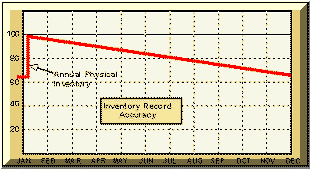The Physical Inventory
Accuracy At Once, for a While
 In
a physical inventory audit, normal operations cease while every inventory item is identified and
counted. The physical counts are then compared to records and, where necessary, the record is
corrected.
In
a physical inventory audit, normal operations cease while every inventory item is identified and
counted. The physical counts are then compared to records and, where necessary, the record is
corrected.
Most firms conduct the physical inventory for financial reasons. However, it also has the effect of correcting errors and improving cycle count programs. Within a few days, accuracy can increase, quickly and dramatically to 98%+.
Then, as figure 2 shows, accuracy begins to drop the moment operations resume. Transactions introduce errors. At one year, accuracy will drop to the initial level, other factors being equal.
Figure 2 shows an initial IRA of 63%. Such a low figure is not too unusual. After the annual inventory in January, IRA rose to about 99%. It then steadily declined to the original 63% by the following December. This gives an overall average of about 80%.
This could be improved by taking a physical inventory every six months. However, this is expensive and frustrating for people. It still gives only a 90% or so average IRA and this is insufficient for MRP/ERP systems. It is undesirable even in manual systems.
For many, it is an unpleasant experience of chaos and boredom. A physical inventory is expensive. It usually involves overtime and sales may suffer. If the result is inaccurate, the money is wasted.
Planning Your Physical Inventory
The key to an accurate, sane and fast inventory is planning. Begin planning at least twelve weeks before the count. Include at least the basic tasks below.
Planning Tasks
1. Set The Count Date(s)
Do this early so everyone has notice. Avoid dates when people are preoccupied such as the days around Thanksgiving and New Year. With several locations, consider counting them on different dates.
2. Select The Method
Bar-Code Readers-- Bar Codes make counting simpler, faster, easier and more accurate. However, they are expensive and require labels on every bin or product.
Count Cards-- Count cards (cards for each product and location) are a "low-tech" alternative to bar-code. Place these cards on shelves or bins before the count starts to allow a sequential count. This facilitates the discovery of "lost" material. Provide each counter some blank cards for newly discovered items.
Count Sheets-- Count sheets (8-1/2" x 11" with about 25 items) are easier to handle than cards. However, because multiple items are listed on a sheet, counters may be tempted to only count the items printed, and overlook misplaced material or products. Sheets usually give less accurate counts.
3. Identify The Counters
With bar code equipment, one person can count a section of your warehouse. With count cards or sheets two-person teams work better. Pair an experienced employee with someone having less knowledge the material.
4. Order Supplies
Supplies may include count cards, bar code readers, clipboards, and computer paper.
5. Police The Area
Clean out the junk, return everything to its proper place, mark all locations and scrub things down. Do this at least two weeks prior to the count.
6. Train People
Almost everyone who participates will require at least some training. among the topics are:
Material Types & Locations
Counting Methods
Safety Procedures
Documentation Procedures
Reconciliation Procedures
Handling Equipment Operation
■ ■ ■ ■ ■ ■ ■



